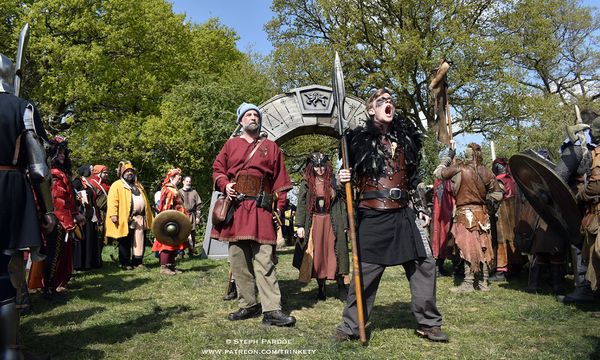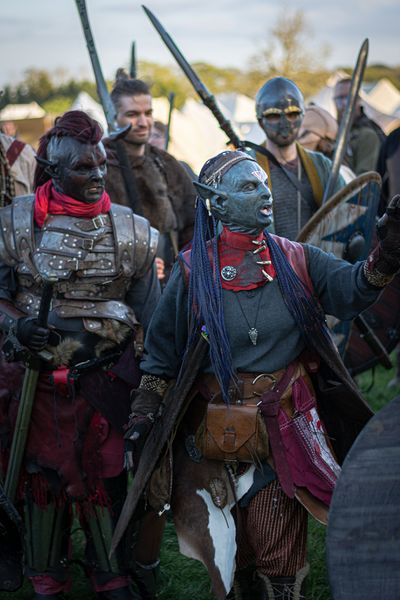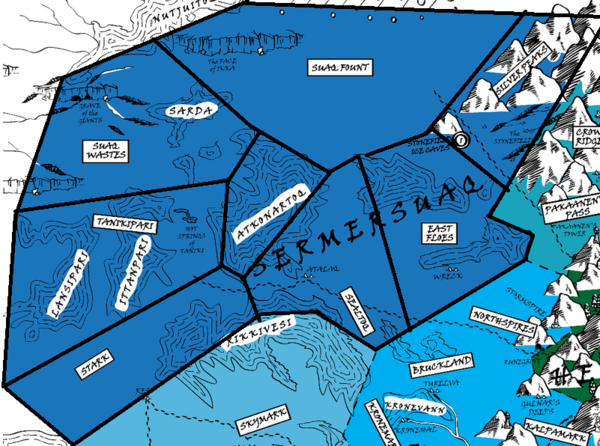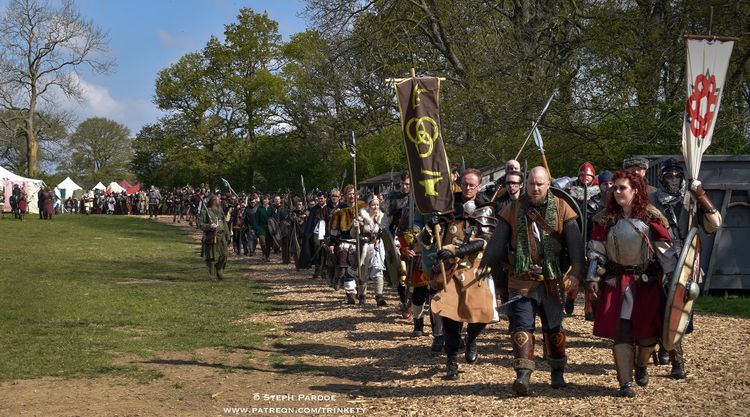Given and denied
Locking Up the Sun
Blood Cloaks, Bold and Loyal heroes of the Empire. An Oath I swore for you. An Oath I keep. March with me, fight beside me again on Sermersuaq's glittering field. The long campaign to retake our home is underway at last. You have shown loyalty to our allies, courage to our foes, pride to one another. Virtue is true and strong in the Empire and your is rewarded with Imperial Arms.
Lofyn Blood-cloak, General of the BloodcloaksIt's been the best part of a year since Imperial armies fought in Sermersuaq. In the weeks following the Winter Solstice, four generals direct their forces to gather at Atalaq, in Sealtoq. The Imperial Orcs of the Summer Storm, the Marcher Drakes, the Bloodcloaks, and the Green Shield of Wintermark. There's a kind of grim determination in the air as the armies come together, especially from the Winterfolk.
Along with the armies themselves come nearly fourteen thousand warriors from warbands led by independent captains, the majority of them fighting alongside the Bloodcloaks. This season, the newest Wintermark army is entwined with the power of Autumn magic - while the lion's share of the heroes fighting alongside the physicks and healers are Winterfolk themselves there are representatives of many other Imperial nations especially Dawn, Navarr, and the Brass Coast. Bound by a common cause, the enchantment that infuses the army makes it easier for these soldiers to fight alongside the Winterfolk, and makes it easier for them to adopt the customs they need to survive in the cold of Sermersuaq. It becomes common to see a flash of bright tabard beneath a warm fur-and-leather coat, or the spark of a vibrant tagelmust peeking out from beneath a heavy Suaq hat.
We are the blessed of the Five-Who-Are-One. We are their talons as they strike against the Jotun, alongside the warriors of the south. We shall turn the thunderous breath of the Terrible Gyre against the foe, and deafen our enemies with the incantations of storm and fury.
Tomoreh Galdramathur, General of the Jaws of Winter's LightningThere's another presence here that raises a few eyebrows, quite apart from the visitors from the distant south. Even those familiar with the recent treaty are a little taken aback when a scarred Thule warlock and her attendants appear and set up camp just out of bow's reach of the walls of Atalaq. There's no suggestion they fear attack; the placement of their tents simply seems to be a manifestation of peculiar Thule politeness. She meets with the generals and captains in her blue-and-blue pavilion, and when the armies begin to move she accompanies them in a leather-and-fur palanquin carried by two burly orcs in cobalt masks who seem unaffected by the Winter chill. Before the Imperial armies leave Atalaq, she conjures three irrigo lizard-owls that spiral up into the cold grey skies, and then arrow off to the north-east.
The Empire's armies cross into East Floes. The Jotun defenders are ready for them, putting up a spirited defence of the halls they have conquered and the walled camps they have established across the tundra. As the Winterfolk armies sweep east between the lakes, the Drakes and the Summer Storm press south. There is particularly fierce fighting on the shores of the lake around Wreck, where the Jotun have forced Suaq thralls to begin laying the foundations for another fortification. On the same day that the armed camp falls, a Navarr messenger reaches the Summer Storm that the Jotun have made good on their promise, and sealed the western end of Pakaanan's Pass. Passage between Sermersuaq and Skarsind is now closed.
An Imperial Orc's life is Sacrifice; For legion, For Home, For the Empire. We go now to lay down our lives to help the Nation who gave us our home retake theirs. Shoulder to Shoulder, Shields overlapped. We face the enemy as one.
Zerk, General of the Summer StormSuaq scouts report that the two armies responsible for the destruction - Torrfyr Blood-drunk's armoured warriors of the Shield of the Mountain and the Skjalderborn led by the Queen of Kalsea's favoured champion Jorgan Hylasson - have come down out of the mountains and are cautiously making their way north-east. They are sticking to the shores of the lake, giving as wide a berth as possible to the foothills of the Silver Peaks. As well they might. As the two Imperial forces meet up, the Thule finally strike.
As the sun rises, the waters of Big Sister and Little Brother sparkle and dance. Everyone can feel the magic taking hold as a wave of enchantment flows down from the mountains and spreads across the plains of Sermersuaq faster than the wind. Everyone feels a burst of vitality, as the Rivers of Life begin to flow. At the same time, a thunderous brazen horn rings out from the north, louder than thunder, clearly not the work of any mundane horn, and the Thule join the battle for Sermersuaq, crashing down on the Skjalderborn and the Shield of the Mountain from the north as the Imperials surge forward to attack them from the rear.
We fight again alongside the Imperial humans, and this time the orcs of Skarsind are our allies also. In the name of the Five, we shall create an iron net and allow none of the red fish to slip through it.
Myrcerud Ferdied, General of the Chasm of ThunderThe fighting is brutal; the Empire may be more interested in conquest than killing but the Shield of the Mountain at least intend to make their enemies pay for every foot they are forced to retreat. The Thule move a little cautiously, testing out not only the Jotun resolve but also the strength of their alliance with the Imperial forces beside which they fight. For three days there are running battles along the shores of the northernmost lake, as Torrfyr Blood-drunk and Jorgan Hylasson try desperately to get to their rendezvous with the main Jotun force.
The retreat sees heavy engagement with the warbands led by independent Jotun champions, including the Yegarra under the walrus banner of Eisa WInterborn, and the aggressive warriors of the Howling Bears. While the main armies keep to the flat land south of the peaks, the champions are more manoeuvrable and able to flank Imperial and Thule forces - but they are matched by the independent Imperial captains bound by common cause with the Bloodcloaks.
Heroes of the Green Shield army. For many seasons now we have fought to defend the homes of our fellow citizens. Now we return to Sermersuaq to liberate our kin from the yoke of the Jotun, and in time return their home to them. We face a fierce and numerous enemy for this cause, and that makes us heroes. For now our business is North. Forth the Green Shield Army!
Iron Osric, General of the Green ShieldAt the end of the third day, along the northern borders of East Floes where the lakes give way to the endless tundra of Suaq Fount, the Skjalderborn and the Shield of the Mountain turn and plant their feet. Behind them rises a crimson wall of roaring Jotun their voices raised in a hymn of battle - the rest of Sermersuaq's defenders have arrived.
Battle of the Three Armies
The Jotun are in a difficult position. They cannot easily defend East Floes in the face of the Thule alliance with the Imperials, and they must know it. But their honour demands that they at least try to hold against the forces arrayed against them. The two sides are almost matched, but the presence of the Imperial captains massively shifts the odds in favour of the Empire. The two largest armies on the Imperial side - the Summer Storm and the Banner of the Rime Hound - form the solid core of the Imperial push and they are met by the equally massive force of the Fell Hammers and the Skjalderborn, the latter's ranks still swollen by the champions of the western orcs.
Gather the hounds, for at last we hunt! We shall test our fangs and our claws against the steel hearts of the Jotun, as our ancestors did! Let their red cloaks lie in pools of blood, crimson against the snow!
Hoosfa Mek, General of the Banner of the Rime HoundAs the two massive forces clash, the Banner of the Rime Hound unleash a trio of war rhinos from within their ranks. These living siege engines crush everything in their path, guided by warlocks empowered with echoing roars that bind their enemies in inescapable chains, leaving them unable to escape the thundering charge of the great furred beasts. The Thule army does not rely solely on the rhinos; packs of lean white-blue furred wolf-hounds battle alongside the orc soldiers, their razor-sharp jaws rending arms and legs whenever they find a loose chink in the armour of their Jotun prey.
The Western orcs are outnumbered; the large number of independent captains fighting alongside the Bloodcloaks alone are by themselves essentially a match for any two of the Jotun armies. The orcs are not suicidal; after it becomes clear they cannot hold East Floes they slowly cede ground. They have rescued the forces of Jorgan Hylasson and Torrfyr Blood-Drunk and must be satisfied with that slightly hollow victory. The slow Imperial advance soon gathers momentum; while the Jotun never break they are forced to retreat again and again until they are finally driven away from the lakes and out onto the open plains.
Neither the Empire nor the Thule rest on their laurels; they continue to harry the Jotun, pushing towards the grand glacier of Ikka's Tears.
No End, No Beginning
The Empire's liberation of Suaq Fount is slow, but steady. The Chasm of Thunder drops behind, consolidating gains in East Floes and then following the main advance out onto the tundra. Their grinding advance allows the Imperial soldiers and the other two Thule armies to focus on pushing the Jotun, rather than dealing with the scattered garrisons of en-thralled settlements.
As the campaign grinds on, it becomes clear that some of the Jotun seem to be focusing their attention in turn - on the Thule and on the Imperial Orcs. The orcs of the Shield of the Mountain in particular seem to relish every opportunity to face their fellow orcs in battle. The tenor of these encounters are subtly different. Against the Imperial Orcs they seem to revel in the sheer physicality of battle, treating the orcs of Skarsind almost like respected rivals rather than hated enemies. There is much mention of Sjöfn of the Bittenblade by those who fight the Summer Storm, and many of those who were with the legion when they first heard the voice of the Jotun ancestor report hearing her voice echoing triumphantly in their heads urging them to conquer their foes and, if they cannot, to embrace a glorious death in battle. The Thule receive no such respect, however. In the clash there are shouted accusations of dishonourable behaviour. The Shield of the Mountain see the Thule's decision to side with the Empire against the Jotun as a strategy driven by greed. A greed they will neither forget nor forgive any time soon. For their part, the Thule seem untroubled by the anger of the Jotun.
Another notable conflict quickly develops between those who fight beneath the walrus banner of Eisa Winterborn, the human champion, and the heroes among the Winterfolk. She and her fellow Yegarra seek every chance to face Winterfolk warriors away from the main clash of battle, warband to warband, and seem to take particular pride in beating the Suaq. There are some signs that those under the walrus banner might be the descendants of Suaq taken as thralls by the Jotun long ago - raised among the western orcs in Tromsa and Skallahn and choosing to fight alongside them rather than live as hunters and fisherfolk. Eisa herself is nearly caught by the Suaq but manages to escape; even after this near brush with death she seems almost foolhardy in her drive to challenge the people of Wintermark.
Diamonds for Tears
As the campaign grinds on it becomes clearer and clearer that the Jotun cannot hold against the Imperials and their allies. A group of dour Marcher beaters among the Drakes capture a Jotun messenger who reveals that the expected support from the garrisons of Olgafsdottirshal and the Fastness of Kalant - the fortifications in Tanikipari and Stark - are long overdue. With their aid, the Jotun might have been able to hold their enemies in the southern part of the Fount. Without them...
As the Spring Equinox approaches, the Jotun armies pull back to the foot of the great glacier and the Pride of Ikka's Tears. it seems that it is here they will make their stand. There are signs that the mine is operating again - the Jotun having cleared the destruction caused by the daring raid launched after the Summer Solstice 383YE, and dealt with the disruption the Imperial heroes left in their wake. There are again signs that the Jotun are in the early stages of attempting to fortify the mine - land cleared and foundations in the process of being laid - but for the time being there are only simple palisades supplemented by a small number of stone walls. Yet, with their backs metaphorically against the wall, the Jotun make another stand and this time they are able to hold the Empire. They cannot reverse their gains, but they can prevent them taking back the westernmost parts of the tundra - and reclaiming the mithril mine. Keen-eyed Kallavesi warriors report that the Jotun are moving the mithril by well-guarded caravan into the Suaq Wastes while their armies hold the mine itself.
The two great armies regroup, seeing two armed camps pitched in the shadow of the vast glacier. Roughly two thousand soldiers fighting to free Sermersuaq - both Imperial and Thule - are dead, or lost, or wounded badly enough they will never fight again. Estimates suggest around the same number of Jotun warriors are likewise casualties of the campaign into Sermersuaq. Without the enchantment laid over the territory by the Thule, the loss of life would have been significantly higher. The Empire has liberated East Floes, and the Jotun are hanging on to Suaq Fount only by their fingertips... but hanging on they are. The relief of Sermersuaq has begun... but it is only the beginning. There is still a great deal more work to be done.
Game Information
The Empire has liberated East Floes, and is four-fifths of the way toward conquering Suaq Fount. As always when facing the Jotun, the Wintermark armies have fought in a way that encourages heroism rather than slaughter. Their ability to conquer territory was increased, and the casualties they inflicted were reduced as were those of the military units fighting alongside them.
Due to an admin error, we left the presence of the two fortifications mentioned in the Wind of War - Olgafsdottirshal and the Fortress of Kalant - off the report that is used for Eyes of the Sun and Moon. As such, we decided not to include the strength of those two castles in the calculations to determine the outcome of the campaign. We've provided an in-character explanation in the form of powerful blizzards. Sometimes the Jotun players have a bad event and their Winds of Fortune cause them trouble for a change ;)
Following the Winter Solstice, the Jotun completed their plan to collapse the western end of Pakaanan's Pass. As such it is no longer possible to move armies through the pass between Sermersuaq and Skarsind. We've updated the Strategic Considerations sections of the territories to reflect this. This also caused the destruction of the Clattering Gulley and the Krampushal. What this will mean for the Krampus is unclear; the Wintermark egregores may have a better idea.
Earthquake Weather (Battle Opportunity)
In the last quiet days before the Spring Equinox, a small group of warlocks from the Jaws of Winter's Lightning invite several of their Imperial peers to meet with them. Their leader - a female orc in red mage armour with a staff topped with a fist-sized crimson jewel - has a proposal for the Imperials. For the Military Council really. A proposal that concerns the Fastness of Kalant and Olgafsdottirshal.
One of the reasons the campaign against the Jotun has been so successful has been that the allied forces were able to avoid their fortifications. Some of the Suaq hunters come from the western regions have already confirmed that Stark, Tanikipari, and the Suaq Wastes have been gripped in a terrible blizzard for several months, no doubt explaining the lack of support by the garrisons there. The blizzard is over now; together the two castles represent strength at least comparable to another Jotun army in Sermersuaq. The Thule believe that these fortifications could also serve as the perfect "anchor points" from which the unpredictable Ice Dragon could provide her powerful boons to the Jotun.
With the problem of these forts in mind, the warlock reveals that the Empire is truly honoured. The Destroyer - Tathenon the Gyre - has focused their attention on Sermersuaq. They have proposed a scheme which might help to deal with one or both of the fortifications if the Empire is interested. During the Spring Equinox, the warlocks of the Jaws of Winter's Lightning can channel the power of the Five-Who-Are-One, using a suitable regio. All the Empire will need to do is provide an escort to such a regio, one aligned with the power of Summer. Once in position, the Five Themselves would rouse the bones of the earth and inflict catastrophic damage on the fortification chosen by the Military Council. The Thule themselves do not care if it is the Fastness of Kalant or Olgafsdottirshal that is destroyed.
In a calm voice, as if discussing the weather, the crimson warlock declares that with a single ritual the Five will annihilate one of the fortifications completely, depending on which one would suit the Imperial plan in Sermersuaq best. She seems particularly keen to make the Imperial magicians understand the implications of this - she barely bothers to conceal her subtext. That the Thule have sufficient ritual magic to annihilate an entire fortification should they so wish. The clear implication is that what the Thule can wield against the Jotun...
Either way. The Thule have even located a suitable regio at Pyhatunturi in the Suaq Wastes. The only problems being that it is not going to be possible for Thule warriors to get close enough in anything like sufficient force to provide their own escort, and that the Jotun are already using that regio. The Yegarra under the walrus banner of Eisa Winterborn are garrisoned near the regio, and will no doubt provide fierce resistance to Imperial attempts to tamper with it. It also seems that it is one of the main resources being used by the Ice Dragon to provide support to the Jotun in Sermersuaq; there are likely to be heralds of the Summer realm there and perhaps even some Summerborn orcs.
Imperial forces will need to provide an escort to the location, defend it while the Five-Who-Are-One raise and direct their magic, and then make sure everyone gets off the battle safely. Or not, as the Imperial generals decide.
The Civil Service have confirmed the presence of a major conjunction of the Sentinel Gate to the vicinity of Pyhatunturi and communicated the location to General Tomoreh Galdramathu. They have also provided an assurance that they will also inform the general if the Military Council have declined the opportunity so that the Thule can get their small force to safety should the Empire choose to go elsewhere.
On Ikka's Trail (Conjunction)
- The opportunity to intercept orcs carrying mithril from Pride of Ikka's Tears has been identified
- Rakner Ravenstorm of Stormspire, the Warden of the Great Raid, has been asked to intercept the Jotun
The actions of Wintermark military captains in the summer of 383YE saw the Jotun's mine workings under the great glacier attacked and pillaged. The surprise action left the western barbarians in disarray and disrupted the mining operations there for two seasons. It now appears the Jotun have repaired the damage and further reinforced the approaches to the mine, preventing any such repeat of the great raid. Yet, the undertaking by brave Wintermarkers has evidently resonated with at least a small number of thralls still working the mine, inspiring them to commit small acts of sabotage and slow down the effective working of the mine. Civil servants have received word from Ikka's Tears that last week a group of Suaq thralls engineered a small rockfall in one of the drift mine access tunnels, dropping the floor out and plunging a shipment of ore down into an icy crevasse. Unbeknownst to the orcs overseeing the mine, other thralls were ready in the crevasse below and were able to spirit away the ore into the network of caves beneath the foot of the glacier. Now all that is needed is a distraction to lure a Jotun force further down the Ikka's Trail, buying the thralls time to move the ore out of the caves and away across the tundra.
Success and Failure: Should a successful intervention be staged on the moraine trail below the tongue of Ikka's Tears then four wains of mithril will be spirited out of the mines from under the noses of the Jotun and to the advancing Imperial armies. This production would have been claimed by the Jotun operating the mine and would likely have gone to supporting their armies, instead it will be provided to Raknar Ravenstorm of Stormspire, the Warden of the Great Raid.
Note: Whilst Raknar has been identified as the most appropriate choice to hold responsibility for ensuring this follow-up raid goes ahead, they do not hold an official Imperial title.
Further Reading
- Winds of War for Spring 384YE
- Thule peace treaty - The Winter 383YE treaty of alliance with the Thule



